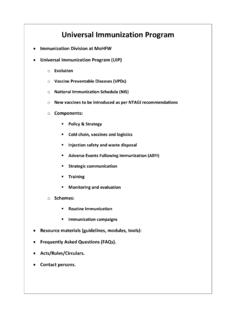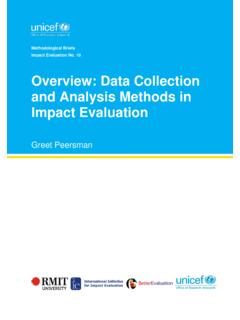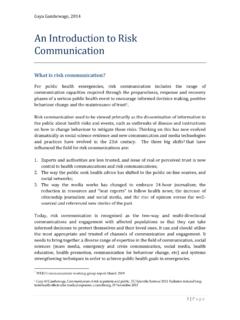Transcription of A Public Health Communication Planning Framework
1 LEARNINGOBJECTIVESBy the end of this chapter, the reader will be able to: Understand how Health Communication fits into the broaderecological model. Select an overall approach to Planning . Identify the key elements of each core strategy based on bestpractices. Identify stakeholder partnerships for a Communication intervention. Create a macro plan for a Health Communication : Health Communication INTHE ECOLOGICAL MODELR eferring back to the ecological model in Chapter 1, ourhealth is affected by our physical environment and limitingor enabling factors created by our society, as well as our ownbehavior and biology. Reciprocally, our physical conditionand behavior affect the Health and social welfare of others,and we obviously affect the physical environment. Publichealth experience has demonstrated that interventions con-ducted on multiple levels of the model are more effectivethan those focusing solely on one 2 1shows someof the ways that the CDC used Health Communication to sup-port interventions directed at the different levels of the eco-logical good example of a multilevel intervention is the tobaccopolicy that addresses taxes on cigarettes, national advertising,worksite activities, and the availability of medical cessationaids ( , nicotine gum, patches), presented in Chapter Public Health CommunicationPlanning Framework Claudia ParvantaIn this chapter, we introduce the example of the nationalfolic acid*campaign managed by the CDC and the NationalCouncil on Folic Acid.
2 The CDC and its partners launched ad-vocacy, Health provider education, community partnerships,and mass media efforts to increase the availability of foods for-tified with folic acid, as well as to increase consumption of folicacid supplements by any woman capable of becoming preg-nant. We will come back to the national folic acid programthroughout the textbook as an ongoing example that is un-usual in scope and the opposite end of the spectrum, many community or-ganizations or Public Health departments plan and executesmall scale interventions on their own. These smaller effortsmust work within the limits set by their organizations (chieflybudgetary), and address limited populations defined by specificfactors ( , geography, Health status, age, maternity status,ethnic identity, sexual orientation, church affiliation, schoolattendance, sports team fans, etc.).Table 2 2illustrates thelevels of the ecological model and how Communication mightbe used to create or support a Public Health Planning for a multilevel, multi-population com-munication program or a highly focused one, the basic plan-ning process is the same.
3 *Folic acid is a B-vitamin that is essential to human Health . It is required for thebody to make DNA and RNA, the blueprints for development of all cells. It isespecially vital to a developing embryo because rapid cell division occurs earlyin fetal development. Consuming folic acid before conception and through thefirst months of pregnancy will prevent 50-75% of neural tube 9/8/10 2:12 PM Page 19 Jones & Bartlett Learning, LLC. NOT FOR SALE OR DISTRIBUTIONAN OVERALL APPROACH TO Planning : BIG WHEEL KEEP ON TURNINGH ealth Communication Planning , execution, and evaluationare often depicted together as a circle to emphasize the ongo-ing nature of program improvement. The National CancerInstitute1 uses the format shown in Figure 2 way to look at this is to break down the complexplanning process into several sub-plans, each with an inherentresearch task:Chapter 2 A Public Health Communication Planning Framework A macro planthat includes analysis of the problem, theecological setting, the core intervention strategy, andthe target population.
4 This stage of Planning is normally undertaken afterepidemiological data indicate there is a Health prob-lem that affects specific groups of people. If there isevidence that a specific intervention has worked toreduce this problem elsewhere, feasibility testingmight be conducted to adapt the intervention to the20 TABLE 2 1 Health Communication at Different Ecological Levels in CDC Folic Acid ProgramEnvironmentalSocietalOrganization alIndividualIncrease number and availability of foods forti-fied with folic fortification level to 400 g of folic acidin fortified cereals, bread, pasta, and otherprepared acid supplements or multivitamins could beprovided at low or no cost to all to promote consumption of folic acidprior to to define adequate fortification levelsin funding and resources should be committedto neural tube defect (NTD) prevention Communication normative campaign topromote daily consumption of folic acidsupplements food sources and technical outreach to obstetri-cians and gynecologists and pediatricians, con-cerning reduced risk of NTDs with proper intakeof folic acid.
5 Healthcare providers could encour-age women to consume folic acid, regardless oftheir plans for future Communication : education and persua-sion to begin consuming 400 g of folic acid dailyif pregnancy is to Food and Drug Administration(FDA).Education and advocacy to private-sector foodand vitamin supplement manufacturers. Promotional support for foods and vitaminscontaining 400 g of folic advocacy to federal and state recruitment with national and com-munity , local Health department support;media training materials; educational mate-rials for healthcare professionals, managed care,and insurance companies, and Health campaigns using entertainment, Public service announcements (PSAs), and printto reach target LevelPrimary InterventionCommunication 9/8/10 2:12 PM Page 20 Jones & Bartlett Learning, LLC. NOT FOR SALE OR DISTRIBUTIONnew population. The less we know about the problem,potential solution, or the intended audience, the moreformative research must be done before taking thenext Planning steps.
6 A strategic Health Communication planthat focuseson specific change objectives, audiences, messages, andmedia. Concepts, messages, materials, and media strategiesare tested at this stage of Planning . This pretesting is sometimes referred to as formative research, and attimes it is considered process research. It shouldprecede finalization of the implementation plan thatcomes next. An implementation (or tactical) planthat says whatwill be done, when, where, how, with what money, andwho is responsible for every piece. Process research is often conducted shortly after the launch of a program to make sure all operationsare running smoothly and that messages are get-ting out and being interpreted as planned. Cor-rections can be made if this assessment is done Overall Approach to Planning : Big Wheel Keep on Turning21 TABLE 2 2 Communication Interventions in the Ecological ModelState, national, globalLiving and workingconditionsSocial, community,familyIndividual behaviorIndividual biology,physiologyPolicies, laws, treaties, movements, : seat belt law; EMPOWER tobaccopolicy (World Health Organization); food fortifi-cation or enrichment regulations; small pox orpolio vaccination programs; border closing orquarantine to control epidemiological conditions; hours; : worker safety; time off and vacationpolicies; creation of walking paths; elimination oflead in gasoline, paint; availability of healthy foodchoices, healthcare norms; elimination of social disparities;provision of community Health and social ser-vices.
7 Cultural rules for group : Community Watch, day care, churchministries of Health , of beliefs, attitudes, motivation, self-efficacy, products, and services through socialmarketing, behavior change communications,paid advertising, or psychological or treatment of illness; healthcareprovider visits; screening to create or maintain policy or law; na-tional and state specific reinforcement advertising;incentive programs; package warnings and labels;government educational campaigns; social mobi-lization, , national immunization days; multi-media emergency information campaign to adviseand calm or worker advocacy (multimedia) to im-prove conditions; awareness and promotion cam-paigns for improved facilities, services; state orlocal lead education campaigns; private-sectoradvertising for healthy food choices, roots campaigns; radio, TV, Internet, printor locale- ( , church, bar) based social market-ing or promotional campaigns; opinion leadersand role models; PSAs; Health fairs, small mediaeducational materials; reinforcement of normsthrough group decision aids; educational materials;guidelines; promotional advertising; reinforce-ment through home, healthcare providers, change Communication to maintain orestablish good Health habits; reminders for screen-ing; healthcare provider Communication duringoffice Model LevelPrimary InterventionCommunication 9/8/10 2:12 PM Page 21 Jones & Bartlett Learning, LLC.
8 NOT FOR SALE OR DISTRIBUTION An evaluation planthat says what aspects of the inter-vention will be monitored or evaluated in order to de-termine the intervention s worth to key most programs want to achieve measurableob-jectives, baseline data often need to be collected be-fore a program is launched. Therefore evaluationplanning must begin in the first days of programdevelopment. A Partnership, continuation,and/orexpansion plansmight also be initiated at the outset of a program to en-sure a broader reach, diffuse expenses, and provide con-tinuity of leadership and ownership. A Dissemination andpublication plans, if CDC developed a software tool called CDCynergyto help program planners develop and implement healthChapter 2 A Public Health Communication Planning Frameworkcommunication programs. CDCynergy refers to each of theseplans as phases. Even though the term phase suggests tak-ing one step at a time, in practice several of the phases needto be considered interactively.
9 However, the development ofthe macro plan is definitely the starting point of the plan-ning process. A Health Communication program can takemore than a year to develop, particularly if a great deal offormative research is necessary. Most interventions run forseveral months to several years and are followed by evalua-tions that may also extend from days to years. The involve-ment of a Health communicator in a program from start tofinish could turn out to be a five or more year chunk of hisor her of the best-known approaches and models forplanning are discussed in Box 2 &StrategyDevelopmentDevelopingand TestingConcepts,Messages, &MaterialsHealthCommunicationProgram CycleImplementationEvaluation &Improvements1243 FIGURE 2 1 Health Communication Planning CycleSource:Redrawn from: National Cancer Health Communication Programs Work, p. 11. (DHHS, 2004.) 9/8/10 2:12 PM Page 22 Jones & Bartlett Learning, LLC. NOT FOR SALE OR DISTRIBUTIOND eveloping the Macro Plan23 Box 2 1 Variations in Health Communication PlanningSome of the variation in how Health Communication Planning is approached is based on whether an organization is at the macro stage,developing a Communication strategy, or managing the program implementation.
10 Plans that you will commonly encounter include: UNICEF s Triple A Cycle. This consists of assess analyze act, and was developed for any form of Planning , not only commu-nication. SCOPE,*created by the Center for Communication Programs at Johns Hopkins University. CDCynergy, developed by Centers for Disease Control and Prevention (CDC). The six-stage Planning model in the National Cancer Institute NCI Pink Book. The social marketing wheel found in multiple social marketing resources, including those supported by the Agency forInternational Development (USAID) and the Turning Point Social Marketing National Excellence Collaborative. SCOPE and CDCynergy are among the more complex Planning tools and use interactive computer models to build a detailed, mul-tifunctional plan based on individual program Health Communication Planning models tend to adapt generic Planning tools to specific development issues, suchas reproductive Health , nutrition, and HIV or other infectious diseases.













